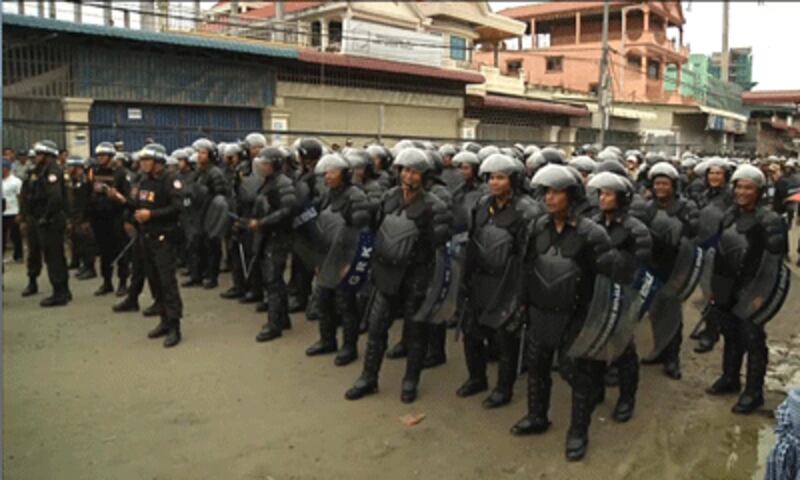The International Labour Organization's revival of a practice to name and shame garment companies in Cambodia that flout workers' rights and safety standards will help boost productivity in the country's biggest export earning industry, a rights group said Friday.
Despite concerns by some garment manufacturers that the action by the ILO's Better Factories Cambodia (BFC) program could force factories to move out, the Cambodian Center for Human Rights (CCHR) said the garment industry would be the eventual winner.
The Phnom Penh-based center welcomed the decision by the program to return to publicly disclosing some of its findings beginning January 2014 based on the monitoring of over 450 factories, urging garment manufacturers and companies currently supplied by Cambodia-based factories to support the initiative.
The center cited the increasing number of protests by garment factory workers as well as the collapse of an internal mezzanine area at one shoe factory killing two workers recently, saying they had heightened awareness of working conditions in Cambodian factories and the prevalent lack of respect for human rights associated with the industry.
On Friday, several hundred military police equipped with anti-riot gear blocked several thousand workers of SL Garment Processing (Cambodia) Ltd., which makes clothing for U.S. brands Levi’s and Gap, from marching to Prime Minister Hun Sen’s house to seek his intervention to resolve a labor dispute over benefits and sackings.
Some 30 workers' representatives were later allowed to meet with Cabinet officials.
“With so many protests occurring on a regular basis over working conditions in the garment industry, it’s becoming increasingly clear that more needs to be done to ensure that garment factories in Cambodia become places where basic human rights are respected," CCHR President Ou Virak said in a statement.
"This will not only improve the lives of the workers but will help to prevent work stoppages and therefore maintain productivity in Cambodia’s key export industry," he said.
Transparency

The center said that while there are concerns that buyers, including well-known international clothing brands, may pull out of Cambodia if the reports are made public, "increasing transparency in relation to garment factory conditions should not only be welcomed but should be encouraged by companies sourcing from Cambodia."
"This initiative will allow for civil society—including consumers—to put pressure on factories to improve working conditions and to
implement human rights safeguards in line with corporate social responsibility, which will ultimately improve productivity and sustainability in the industry."
CCHR recently published a Garment Factory Map, which matched up factories with the different brands that they supply, and Ou Virak felt it was an "initial step" towards greater transparency in the industry.
The ILO-BFC announced this week that it would begin disclosing in January assessment information of individual factories’ compliance with Cambodian labor law and international labor standards, making it the only program in Southeast Asia to use greater transparency to accelerate improvements across the garment sector.
It will also for the first time disclose details about strikes and labor unions, noting unions’ compliance with legal strike requirements.
“We believe that our public disclosure program introduces a new and urgently needed tool for change," BFC’s Chief Technical Advisor Jill Tucker said in a statement.
"We hope that public exposure will prove beneficial to factories that comply with the law, and encourage those in violation of these measures to improve," she said. "We urge brands, auditing firms, and corporate social responsibility organizations to join us in this step towards greater transparency and increased accountability in the apparel sector.”
Under the plan, for factories that have had two or more assessments, a dedicated public website will disclose their compliance on 21 critical issues including fire safety, freedom of association, child labor, and accurate payment of regular and overtime wages.
More information will be disclosed for a sub-set of factories that have been monitored at least three times and have failed to comply with a broader scope of legal requirements included in BFC’s assessments.
Public disclosure reports will be published quarterly, and all factories and trade unions included in the reports will have the opportunity to provide information or update their progress directly on the website.
H&M, a large international company sourcing from Cambodia, expressed support for the program.
“We believe that the public disclosure of Better Factories Cambodia’s assessment results is a positive step in the right direction," Anna Gedda, Social Sustainability Manager at H&M, said in the ILO-BFC statement. "The industry has now taken the lead towards greater transparency to accelerate improvements across the whole garment sector in Cambodia.”
BFC was established after the signing of the 1999 US-Cambodia Textile and Apparel Trade Agreement (UCTA) in order ensure that the country's garment factories were respecting worker rights in return for enhanced access to the U.S. market.
However, import quotas ended in 2005 and the BFC's role changed. Its public reports were compiled with less transparency, possibly due to the absence of a link between textile exports and improving labor standards.
Reported by RFA's Khmer Service. Translated by Samean Yun. Written in English by Parameswaran Ponnudurai.
